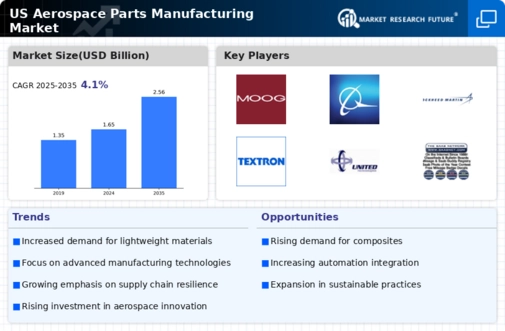The US Aerospace Parts Manufacturing Market is characterized by a highly competitive environment, driven by advancements in technology, increasing demand for aircraft, and the need for high-quality components. This sector encompasses a diverse range of manufacturers, from small-scale firms to large prime contractors, each contributing specialized parts and technologies that cater to various aerospace applications. The market landscape is influenced by factors such as regulatory standards, innovation in manufacturing processes, and the growing emphasis on efficiency and sustainability.
Consequently, companies within this market are continuously seeking to enhance their offerings and establish a stronger foothold by leveraging strategic partnerships, investments in research and development, and expanding their capabilities to meet the evolving needs of aerospace manufacturers and operators.Moog stands out in the US Aerospace Parts Manufacturing Market with a reputation for precision and reliability in its offerings, catering to both commercial and military aerospace sectors. The company has established a robust presence characterized by deep-rooted expertise in flight control systems, actuation technology, and propulsion systems.
Moog's commitment to innovation is reflected in its continuous investment in research and development, which enables the company to stay ahead of industry trends and deliver cutting-edge solutions. The strength of Moog lies in its ability to adapt to customer requirements and maintain rigorous quality standards, which solidifies its position as a trusted partner in the aerospace supply chain.
The company’s successful track record in meeting stringent industry requirements contributes to its competitive edge, as it builds long-standing relationships with key aerospace manufacturers and customers.Raytheon Technologies plays a significant role in the US Aerospace Parts Manufacturing Market, showcasing a diverse range of products and services aimed at enhancing the safety and efficiency of aerospace systems. The company’s core competencies lie in advanced technologies such as avionics, engines, and aerospace components, which are pivotal in both commercial and defense sectors.
Raytheon Technologies has a strong market presence, bolstered by significant mergers and acquisitions that have expanded its capabilities and innovation potential. The integration of these assets enables the company to provide comprehensive and technologically advanced solutions tailored to the specific needs of its customers. Additionally, Raytheon Technologies emphasizes sustainability and efficiency in its operations, further strengthening its appeal in a growing market that prioritizes responsible manufacturing practices. Its focus on developing next-generation aerospace solutions underscores its commitment to leading the sector in innovation and performance, thus solidifying its competitive position in the US market.






















Leave a Comment